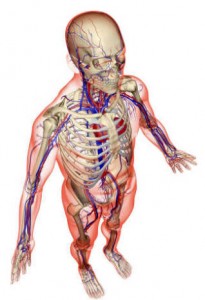By Joseph Magnant, MD, FACS –


Of the estimated 35-40 million adult Americans who suffer from significant superficial venous insufficiency, or venous reflux disease, many are focused solely on its visual or cosmetic impact and are often unaware of the other physical problems they have which may be related to this disease. Many physicians are also involved in the care of this large group of patients; however the signs and symptoms of significant venous insufficiency are often elusive. Patients may have undergone dermatologic biopsy of discolored skin around the ankle, with resultant difficult to heal biopsy sites. Others may have undergone cardiology evaluation for leg swelling or fluid overload; urologic evaluation for bladder problems manifest as nocturnal urination; or neurologic evaluation for neuropathy, leg cramps or restless legs syndrome. Others may have spent months undergoing wound care for what were thought to be “diabetic ulcers” or other traumatic ulcers. There are a myriad of presentations of venous insufficiency other than the garden variety, “Varicose veins or spider veins.”
Skill, Experience, Training
The role of the modern, educated and dedicated Vein Specialist is to educate both patients and physicians of all specialties regarding routine as well as the more obscure presentations of venous insufficiency. Equally as important as the training, skill and dedication of the Vein Specialist are the same three qualities of the Vascular Technologist. Unlike the CT scan or MRI, both of which gather and present radiographic data in a more standardized and mechanized fashion for final interpretation by the physician, quality ultrasonography of any organ system or blood vessel is critically dependent on the skill, experience and training of the individual technologist. In the field of Phlebology, or Venous Disease management, establishing the presence or absence of deep venous thrombosis or superficial venous thrombosis is only one goal of the exam. The most critical goal in the evaluation of patients with one or more of the myriad of symptoms which fall under the broad umbrella diagnosis of Venous Insufficiency is the identification of specific insufficient veins as well as the stratification of severity of the insufficiency.
What is Significant Insufficiency?
By definition, “significant insufficiency” is defined as greater than 0.5 seconds of venous reflux with the Valsalva maneuver or with manual augmentation. In our experience of treating thousands of patients with the full spectrum of disease, this criterion has proven to be woefully inadequate in identifying which patients are most likely to benefit from endovenous ablation. Many patients have more than one of the potential 5 superficial leg veins identified as insufficient and 5-10% of our patients have combined superficial and deep vein insufficiency. Thus, stratification of the severity of insufficiency or reflux times, rather than using this arbitrary cutoff of 0.5 seconds is critical to determining which of the superficial veins would benefit from endovenous ablation, and in cases of mixed insufficiency, the reflux times (in seconds) as well as the reflux velocities are absolutely necessary to selecting patients likely to realize significant benefit. If one suspects their patient may have venous insufficiency, it is our recommendation to refer that patient to a qualified Vein Specialist for the full evaluation including the venous insufficiency ultrasound.
Most Advanced Evaluation and Treatment Techniques
Our goal is not to simply find patients with leaky veins and seal them. We focus on cultivating interest in and awareness of venous insufficiency to the general public as well as reaching out to and offering educational materials to physicians of all backgrounds and specialties. Venous insufficiency is more of an umbrella diagnosis which encompasses a much broader patient population than those with only the most obvious clinical findings of bulging varicose veins. Our website offers video lectures and discussions about the historical treatments of venous insufficiency and more importantly up to date information on the modern evaluation and treatment techniques which we have been employing for the last 10 years. We are dedicated to defining venous insufficiency in as specific and individual terms as possible so that patients and physicians will be able to fully appreciate the full spectrum of this disease. Our extensive gallery of pre and post procedure photographs illustrates this full spectrum and is just a small sample of our actual patients.
Vein Specialists is 100% focused on evaluating patients with ultrasound, stratifying the disease we find, correlating these findings with the patient’s clinical findings, and determining whether endovenous ablation or other procedures have a reasonable chance of improving their clinical condition. These conditions may be a bit more obscure than the garden variety varicose or spider veins and we encourage physicians to include venous insufficiency in the differential diagnosis in their patients with swollen legs, non-healing ulcers, restless legs syndrome, nocturnal leg cramps, nocturnal urination in women, neuropathy, tarsal tunnel syndrome, volume overload, and other symptoms affecting the lower extremities.
Successful Patient Treatments
In the past few months, I have seen a few dozen young women who have had urologic evaluations for nocturnal urination (all with swollen legs) and we have documented severe superficial insufficiency. Following successful endovenous ablation of the insufficient superficial veins, their nocturnal diuresis has resolved as the cause of their edema has been cured. Other patients have presented with the diagnosis of idiopathic lymphedema of one or both legs without any identifiable surgical, infectious or familial cause yet have not been studied for venous insufficiency. Yes, these patients also had severe superficial venous insufficiency and the only way to determine the venous contribution to their “lymphedema” was to seal the severely abnormal veins.
Other musculoskeletal and orthopedic conditions I have recently encountered and achieved success after treatment of their severe insufficiency include tarsal tunnel syndrome in a 40 year old male who failed their surgical tarsal tunnel releases. He was noted on the op note to have extensive varices in the tunnel and second opinion podiatry evaluation led to referral for further venous evaluation and the diagnosis of severe bilateral great saphenous vein insufficiency was identified by our exam. Staged endovenous ablation after trial of compression hose resulted in near complete resolution of his preop symptoms. Tendonitis around the distal leg, ankle or foot in a patient with severe leg swelling or other more obvious signs of venous insufficiency such as skin discoloration, thickening or large varicose veins in the same extremity, should prompt one to consider venous insufficiency as a potential contributing factor and referral for formal venous evaluation would be logical.
Experts in the Evaluation and Treatment of Venous Insufficiency
We appreciate the confidence many physicians have placed in us in referring their patients and hope that physicians will continue to recognize the wide range of clinical presentations of significant venous insufficiency, some of which are often somewhat obscure, and allow us the opportunity to offer their patients a thorough, scientific venous examination and ultrasound evaluation, and trust that we will treat their patients according to the Golden rule. When severe correlative disease is identified, conservative therapy has proven ineffective and the likelihood for significant clinical improvement is near certain.
Vein Specialists
239.694.VEIN
www.weknowveins.com
 Southwest Florida's Health and Wellness Magazine Health and Wellness Articles
Southwest Florida's Health and Wellness Magazine Health and Wellness Articles

